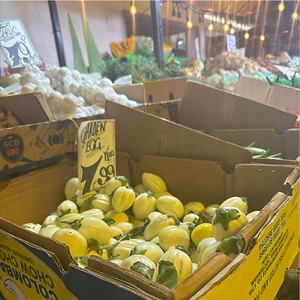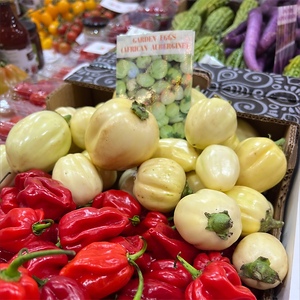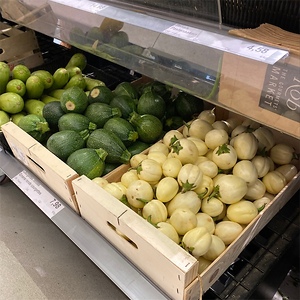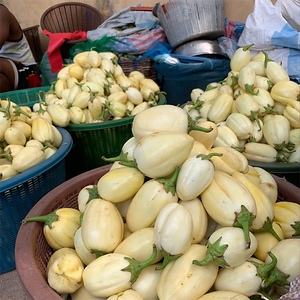

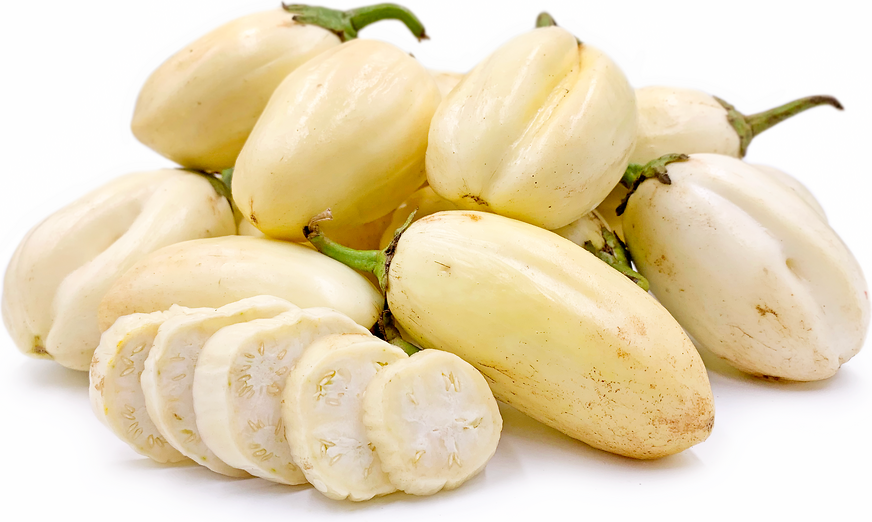
Garden Egg Eggplant
Estimated Inventory, lb : 0
Description/Taste
Garden Egg eggplants are small to medium in size, averaging 6-8 centimeters in length, and are teardrop to slightly oblong in shape. The smooth skin is taut, glossy, and green when young, transforming to white and yellow when mature. Underneath the surface of the thin skin, the flesh is tender, aqueous, spongy, pale yellow to white, and encases many small, flat seeds. Garden Egg eggplants have a crunchy texture with a mild and slightly bitter flavor.
Seasons/Availability
Garden Egg eggplants are available year-round.
Current Facts
Garden Egg eggplants are botanically a member of the Solanaceae family and grow on sprawling, climbing vines. Considered a fruit, but cooked as a vegetable, there has been some debate on the classification of Garden Egg eggplants, with some experts believing it belongs to Solanum aethiopicum while other experts believe it belongs to Solanum gilo. Eggplants are considered one of the most economically important crops in Africa, along with peppers and tomatoes, and the fresh fruits are harvested daily from home gardens and transported into town for resale. Garden Egg eggplants provide a steady source of income for farmers as they are easy-to-grow, fast-harvesting, and produce high yields, and locals favor the fruits for their slightly bitter flavor.
Nutritional Value
Garden Egg eggplants are a good source of potassium and fiber, and also contain some vitamin C, iron, calcium, and beta-carotene.
Applications
Garden Egg eggplants can be utilized raw, similarly to fresh tomatoes, but are predominately consumed in cooked applications such as boiling, sautéing, and steaming. The fruits can be boiled and then chopped or diced into stews and soups. They are also cooked and consumed with chile paste, grilled with other vegetables, mixed into curries, cooked and mashed, pureed into juice, or sautéed and served with starchy items such as rice, yams, plantains, and couscous. In addition to the fruit, in some countries, the leaves and stems of the Garden Egg eggplant are consumed by steaming or sautéing, and the fruit can also be found in canned form. Garden Egg eggplants pair well with meats such as fish, beef, and poultry, garlic, onions, ginger, nutmeg, anise, lemongrass, scotch bonnet peppers, green beans, red bell pepper, mushrooms, tomatoes, curry paste, and coconut milk. The fruits will keep up to three months when stored at room temperature and will dry out over time but are still edible.
Ethnic/Cultural Info
In Ghana, Garden Egg eggplants are grown in small gardens and are consumed as an inexpensive and widely available meat-substitute. Sold on busy street corners, in fresh markets, and along roadsides in small stands, Garden Egg eggplants are consumed on a daily basis and are also deeply rooted in cultural traditions. Representing fertility, friendship, and respect, Garden Egg eggplants are given as gifts at social events, weddings, and gatherings. In Nigeria, Garden Egg eggplants are also served at special events with ose-oji, which is a spicy, ground paste made out of peanuts, spices, and peppers.
Geography/History
Garden Egg eggplants are native to sub-Saharan Africa and have been cultivated since ancient times. In the late 1500s, the Garden Egg was introduced to England where it became trendy, earning the fruit it’s egg-shaped name and remained in the spotlight until the purple eggplant was introduced from Asia. Today Garden Egg eggplants are widely grown and found at local markets in Africa, Southeast Asia, Europe, Brazil, the Caribbean, and in select regions in the United States.
Recipe Ideas
Recipes that include Garden Egg Eggplant. One
| Foods from Africa |
|
African Garden Egg Curry |
| Biscuits and Ladles |
|
Garden Egg Stew with Koobi |



